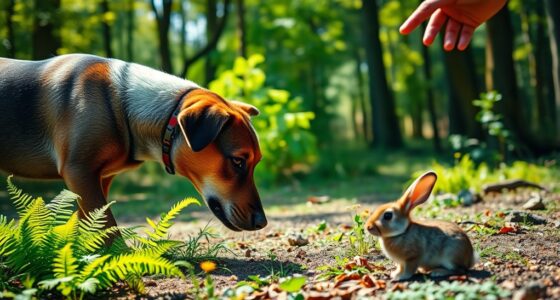When traveling with pets, incorporate safe foraging activities to keep them mentally stimulated and reduce stress. Use pet-friendly plants and treats like blueberries or carrots, and supervise closely to prevent ingestion of toxic plants or objects. Create secure environments with fences and barriers, and hide treats to encourage exploration. Gradually introduce these routines to help your pet feel secure. Keep exploring for more tips on making travel enjoyable and safe for your furry friend.
Key Takeaways
- Use portable foraging tools like snuffle mats and hide treats to encourage safe exploration during travel.
- Incorporate pet-friendly herbs and safe plants to stimulate natural foraging instincts in new environments.
- Supervise outdoor foraging to prevent ingestion of toxic plants, hazardous objects, or spoiled food.
- Gradually introduce foraging activities before trips to build confidence and reduce stress during travel.
- Regularly inspect surroundings for hazards, and keep harmful items out of reach to ensure safe foraging experiences.
The Benefits of Foraging During Travel
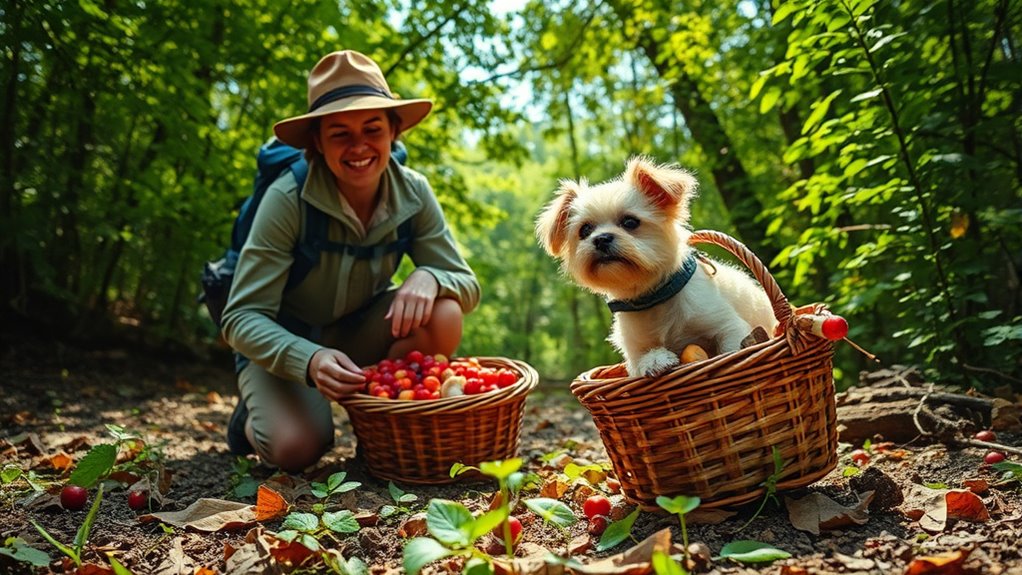
Travel can be stressful for pets, but incorporating foraging activities helps keep them mentally stimulated and engaged. Foraging provides essential enrichment, mimicking natural behaviors and giving your pet a sense of purpose. When you include puzzle feeders or hide treats during travel, it encourages natural instincts, which can substantially reduce anxiety caused by unfamiliar environments. These activities not only promote relaxation but also serve as stress relief, helping your pet feel more secure amid disruptions. Additionally, engaging in foraging can support digestive health and prevent boredom-related destructive behaviors. By integrating simple foraging tasks into your travel routine, you enhance your pet’s overall well-being, making journeys more comfortable and positive for both of you. Understanding your pet’s specific needs and environmental enrichment can help you plan smarter foraging activities during travel. Incorporating training techniques that simulate natural foraging can further improve your pet’s adaptability and confidence in new settings. Moreover, aligning with the Law of Attraction principles by maintaining a positive and relaxed energy can contribute to a smoother travel experience for your pet. Recognizing the importance of mental stimulation can also inspire you to create tailored activities that suit your pet’s unique preferences and personality.
Safe and Suitable Foraging Items for Pets
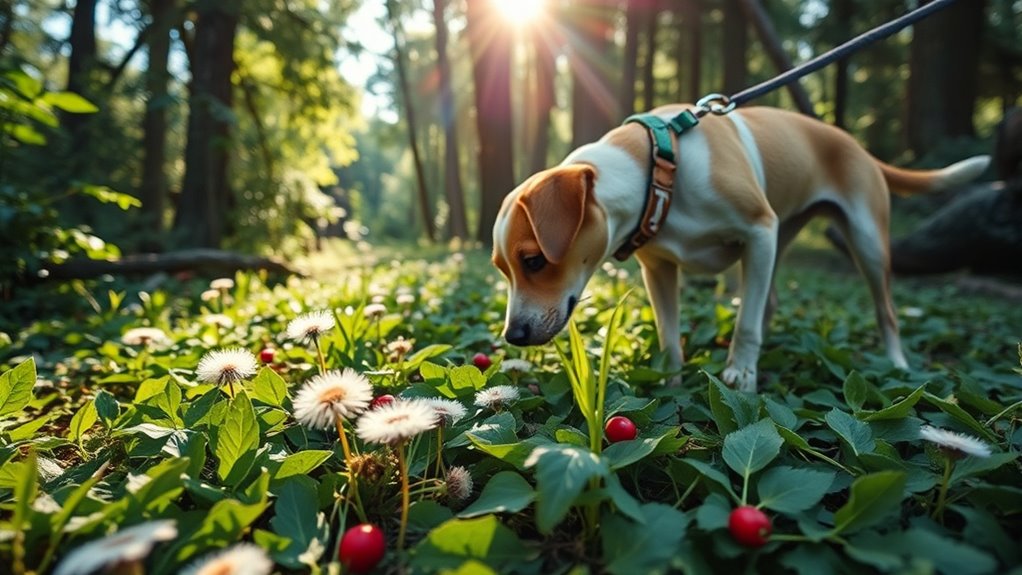
When foraging with your pets, choose safe items like apples (without seeds), blueberries, or carrots for dogs, and catnip or cat grass for cats. Steer clear of toxic plants such as grapes, onions, or mushrooms, which can cause serious health issues. Always supervise their foraging and consult your vet if you’re unsure about any new treats or greens. Considering the importance of safe foraging, understanding pet-friendly plants can help you identify which items are safe and suitable for your pets. Being aware of toxic plants common in your area can further prevent accidental poisoning during outdoor foraging. Additionally, knowing safe foraging practices can help ensure your pets remain healthy and protected while exploring nature.
Safe Edible Foraging Items
Are you wondering which foraging items are safe and suitable for your pets? When considering foraging for your pet, safety is key. Fresh blueberries are an excellent choice—they’re low in calories and high in antioxidants, but only give them in moderation. Carrots are crunchy, healthy treats that provide fiber and beta-carotene, perfect for foraging from gardens or wild areas. Green leafy vegetables like dandelion greens and spinach can also be safely foraged; just wash them thoroughly before feeding. Apples, free of seeds and core, supply vitamins A and C, but should be offered sparingly due to their natural sugar content. Cucumber slices are hydrating, low-calorie treats ideal for hot weather, and safe when fed in appropriate portions.
Non-Toxic Plant Options
Many common houseplants are safe for pets and make excellent foraging options. Non-toxic plants like spider plants and Boston ferns are perfect choices for pet foraging, providing safe greenery to explore. Outdoors, edible plants such as dandelions and violets are non-toxic and can be safely nibbling spots for your pets during outdoor adventures. It’s essential to avoid plants like lilies, azaleas, and sago palms, which are highly toxic and pose serious health risks. Herbs like basil, mint, and rosemary are not only safe but also aromatic, making them ideal for foraging and enrichment. Always double-check plant identification with reliable sources before allowing your pets to forage, ensuring you select safe, non-toxic plants that promote healthy exploration. Additionally, choosing plants that are vetting-approved can help ensure your pet’s safety during foraging activities. Being aware of plant toxicity levels is crucial to prevent accidental poisoning and keep your furry friends safe. Educating yourself about dog names and their characteristics can also enhance your understanding of your pet’s needs and behaviors during outdoor activities. Recognizing the signs of poisoning can help you respond quickly if your pet shows any adverse reactions during foraging. Moreover, consulting with a veterinarian about safe plants can provide personalized guidance tailored to your pet’s health.
Creating a Secure Environment for Foraging
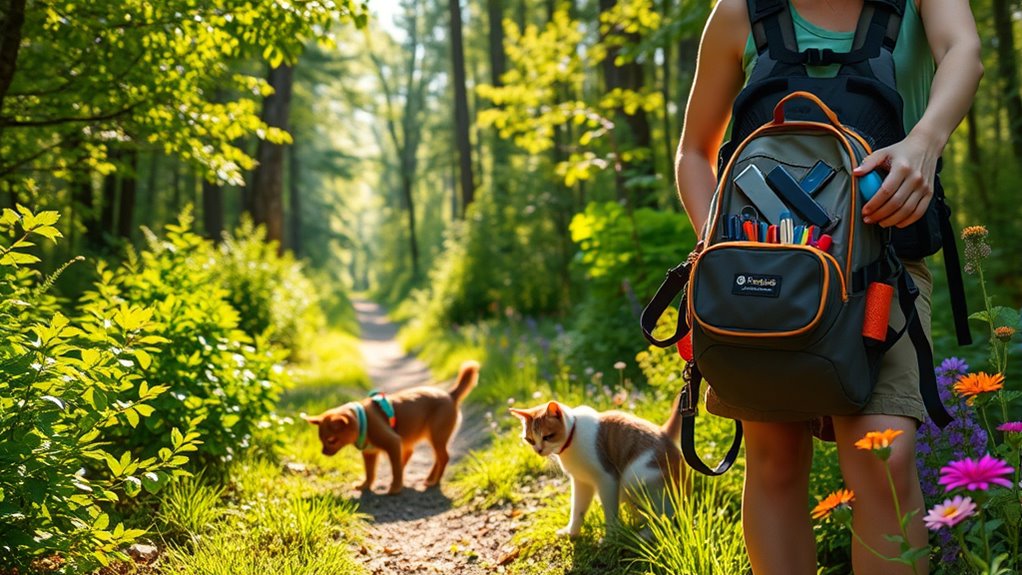
How can you guarantee your pets stay safe while foraging outdoors? The key is creating a secure environment. Use fencing that’s high and sturdy to prevent escapes. Regularly inspect the area for hazards like toxic plants or sharp objects, and remove them immediately. Keep hazardous items and food scraps securely stored to prevent accidental ingestion. Always supervise your pets closely; their curiosity can lead them into dangerous zones. Consider using baby gates or portable barriers to restrict access to unsafe areas. Setting clear boundaries minimizes risks and ensures your pet’s safety. Remember, a well-supervised, fenced space is essential for safe foraging. Additionally, understanding the hazards of toxic plants can help you better prepare the environment for your pets. Being aware of the contrast ratio of your fencing and barriers can ensure they are visible and effective, providing an extra layer of security. Ensuring your fencing has adequate visibility can further prevent accidents and enhance safety during outdoor foraging. Regularly checking the compliance with safety standards of your fencing and barriers can also help maintain a secure environment. Being knowledgeable about local wildlife can help prevent encounters that might harm your pets.
Incorporating Foraging Into Your Travel Routine
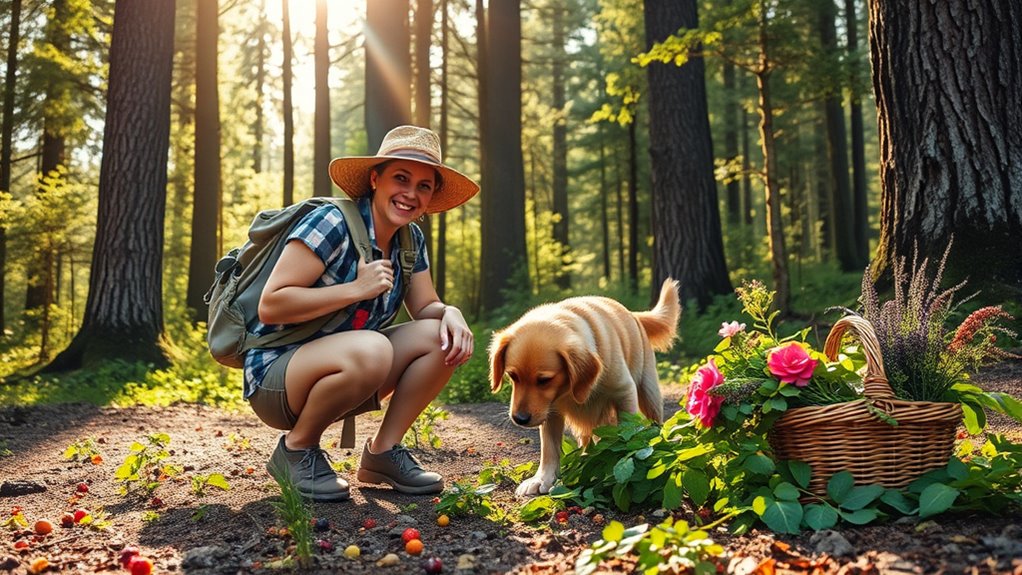
Wondering how to keep your pet mentally engaged during travel? Incorporating foraging into your travel routine is a great way to provide mental stimulation and reduce boredom. Bring along portable, lightweight foraging tools like snuffle mats or scent trails that are easy to pack and use at hotels, parks, or rest stops. Use dried herbs such as catnip or valerian to spark interest and create positive associations with foraging activities. Hiding treats or kibble in different spots around your accommodation encourages exploration and keeps your pet engaged. To build confidence and minimize stress, introduce these foraging exercises gradually before your trip. Incorporating knowledge of symptoms of breast cancer can help you stay attentive to your pet’s health and well-being during travel. Additionally, being aware of effective tick prevention for dogs ensures you can protect your pet from parasites during outdoor activities. Staying informed about animal health can further enhance your preparedness and ensure your pet’s safety. Understanding stress reduction techniques can also help in making travel a more comfortable experience for your furry friend. By integrating foraging into your daily travel routine, you help keep your pet mentally active and happy on the go.
Monitoring and Supervising Your Pet’s Foraging Activities
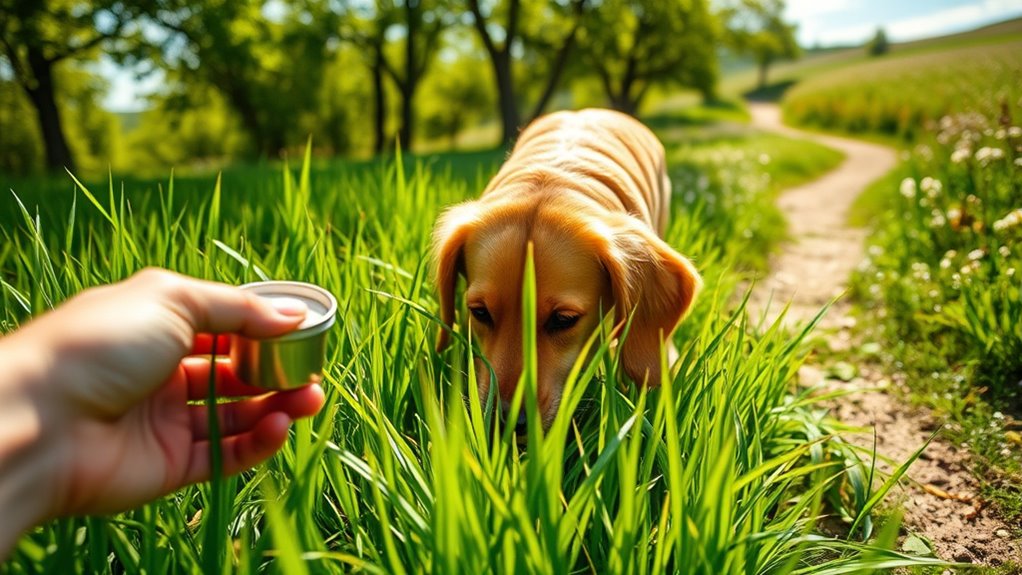
As your pet explores new areas, keep a close eye on what they’re eating. Limiting access to unknown plants or objects helps prevent health risks, and using a leash or enclosure adds extra control. Regularly check the environment to spot hazards before your pet ingests something harmful. Being aware of potential hazards in the environment can further ensure your pet’s safety during outdoor adventures.
Observe Foraging Behaviors Closely
To keep your pet safe during outdoor adventures, it’s essential to closely observe their foraging behaviors. Pay attention to how they sniff, dig, or hunt, as these actions reveal their natural instincts and preferences. Supervision is key to ensuring they don’t ingest harmful plants, insects, or unknown objects. Use verbal cues and positive reinforcement to guide their foraging, encouraging safe exploration. Regularly check on your pet after they forage to assess their condition and prevent choking or toxic ingestion. Keep a record of what they forage to better understand their tendencies and adjust supervision strategies accordingly. By staying vigilant and attentive, you help safeguard your pet’s safety while allowing them to enjoy the outdoors responsibly.
Limit Access to Hazards
Supervising your pet closely is essential to prevent them from ingesting harmful plants, foods, or objects during outdoor foraging. Keep hazardous items like trash, spoiled food, or toxic plants out of their reach. Using a leash is a simple way to restrict access to areas where dangerous wildlife or substances may be present. Stay vigilant and monitor their movements, especially in unfamiliar environments. Be aware of local hazards such as poisonous berries or chemical residues like pesticides, and ensure your pet doesn’t contact or consume them. Regularly check your pet’s mouth and paws for any contact with toxins or hazardous items. By limiting access to these dangers, you reduce the risk of poisoning or injury during your outdoor adventures.
Use Supervision and Training
Keeping a close eye on your pet during outdoor outings helps prevent them from picking up or ingesting harmful plants, insects, or objects. Supervision is key to managing your pet’s foraging instincts and ensuring safety. Use consistent training to help your pet respond reliably to commands like “leave it” and “drop it,” giving you control over their foraging impulses. Stay attentive to their environment so you can quickly intervene if they start to forage or pick up unfamiliar items. To further reduce risks, establish designated, safe areas for foraging. Also, provide supervised enrichment activities such as puzzle toys or controlled foraging games to satisfy their natural instincts safely.
- Protects your pet from dangerous hazards
- Builds trust through consistent training
- Keeps outdoor adventures safe and fun
Tips for Introducing Foraging to Your Pet During Trips
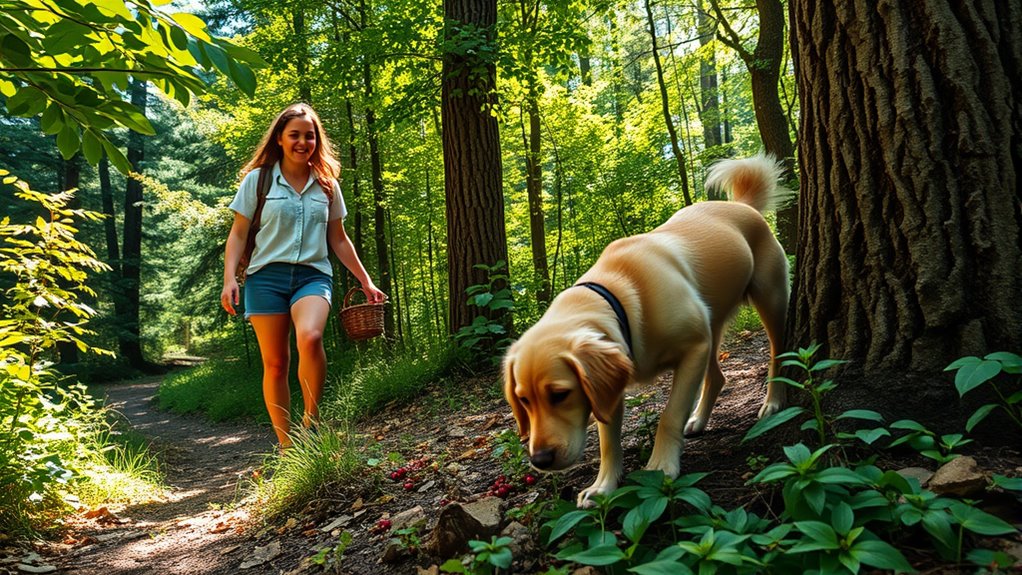
Introducing foraging activities gradually is key to helping your pet adapt to new environments during trips. Start by hiding treats or kibble in puzzle toys or around familiar areas to encourage natural hunting instincts. Using scent-based foraging games, like hiding treats in different spots, engages your pet’s sense of smell and boosts mental stimulation. Begin with simple challenges in familiar settings, then gradually introduce more complex tasks at your travel destination. Always supervise your pet during foraging to prevent ingestion of harmful items and ensure safety. Incorporate foraging into your pet’s routine by offering treats or meals in a foraging style, which reduces boredom and provides enriching experiences. This approach makes travel more enjoyable and mentally rewarding for your furry companion.
Frequently Asked Questions
What Is the Best Way to Travel With Pets?
When choosing the best way to travel with your pets, consider their size, health, and temperament. For road trips, use crash-tested harnesses or carriers and plan regular breaks to keep them comfortable. If flying, follow airline policies for in-cabin or cargo travel. Always consult your vet beforehand to confirm your pet’s well-being and prepare them with familiar items to reduce stress during the journey.
Which Airline Is the Most Pet Friendly?
They say “the early bird catches the worm,” and that’s true when choosing a pet-friendly airline. Alaska Airlines leads with policies allowing small cats and dogs in the cabin, plus designated pet relief areas. JetBlue also scores high with its pet-friendly attitude and helpful guide. Consider your pet’s needs, airline restrictions, and comfort, then pick the airline that best aligns with your travel plans for a smooth journey.
Is It Better to Fly Pets as Cargo or Checked Baggage?
When deciding whether to fly your pet as cargo or checked baggage, consider your pet’s size and the airline’s policies. Flying as cargo offers more space and less stress but involves strict crate requirements and potential temperature risks. Checked baggage might be more straightforward for smaller pets, but some airlines restrict certain breeds or impose weight limits. Always check airline guidelines and weather conditions to guarantee your pet’s safety and comfort.
How Do People Travel if They Have Pets?
When you have pets, you typically travel by car, as it offers flexibility and easier access to veterinary care. Some opt for pet-friendly accommodations like hotels or rentals, while others choose airlines that allow small pets in cabins or hire private transportation for maximum comfort. Planning ahead is key—research destination pet regulations, book pet-friendly lodgings, and pack essentials to make your journey smooth and enjoyable for both of you.
Conclusion
As you explore new places with your pet, the potential for foraging opens exciting possibilities—yet it’s not without risks. Will you recognize the perfect foraging spot or overlook a danger? By staying vigilant and prepared, you can turn every trip into a rewarding adventure. The question remains: are you ready to uncover the secret treasures waiting just beneath the surface? The next foraging discovery might be closer than you think—if you’re willing to look.





